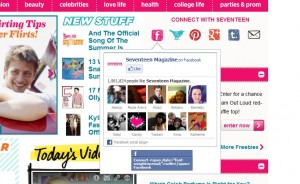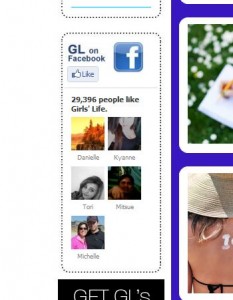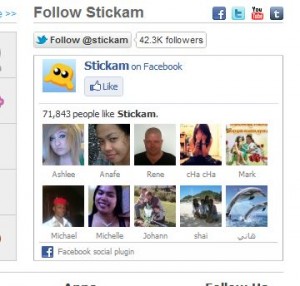Here are three images from Facebook facepiles, those ubiquitous groups of faces seen on an alarming number of websites:
1. This is from Seventeen Magazine.

2. This is from Girl’s Life magazine.

3. This is from Stickam.com, a very popular teen webcam chat site.

These Facebook facepiles are from three popular teen websites. All three show Facebook profiles of Facebook users who have clicked the ‘like’ button on the respective company’s site. Facebook tells us that this social plugin will only show the profiles of friends of the user who views the facepile. In these three cases, and many more that we’ve discovered, this is not the case. The profile photos, complete with clickable links to the user’s Facebook profile page, are all complete strangers and, in almost every case, are profiles of teen users. Some of the profiles shown are those of very young users, we should add.
Do you see a problem with this? We do. There is no harm in a facepile of your friends on a website where you and many of your friends have clicked ‘like’. There is harm in going to a website where you can easily click on someone’s profile photo and get instant access to their Facebook profile. There is even more harm if that profile belongs to a teen Facebook user, wouldn’t you agree?
Here’s what Facebook has to say about this: https://www.facebook.com/settings?tab=ads
The key lines are these:
“You may see social context on third party sites, including in adverts, through Facebook social plugins. Although social plugins enable you to have a social experience on a third party site, Facebook does not share your information with the third party sites hosting the social plugins. Learn more about social plugins.”
The social plugins query leads you to this page: https://developers.facebook.com/docs/plugins/
There is nothing on that page about strangers having access to your Facebook profile. If you click the word ‘facepile’ on the left side of that page, you are taken to this page:
https://developers.facebook.com/docs/reference/plugins/facepile/ which describes the implementation of the facepile but, again, there is no mention of the faces being clickable to either friends or strangers.
What we have here is an incomplete, and dangerous, flaw in the Facebook system. In the rush to monetize user profiles, Facebook has opened the doors to abuse of its own system. Facebook isn’t a dating site. It’s for friends, people who really know each other. Why then is it possible to click your way to profiles of complete strangers? Why is it possible for complete strangers to click their way to your Facebook profile? Something is wrong in this scenario and we really wish that Facebook would change the policy.
In previous posts, we’ve shown examples of proper implementation of the facepile social plugin, notably on the Mashable.com site. If you haven’t ‘liked’ Mashable, then you see no facepile. If you have clicked ‘like’ then you see a facepile but one that shows only your friends who have also ‘liked’ Mashable. The plugin can work the way it’s supposed to. We’re asking why it doesn’t work that way all the time.
Thanks for reading! Please share this post, retweet it, post it on Facebook, whatever it takes to clear up this problem.

Did you research the facepile widget at all? If so, you would see that all the examples you post are not facepile, but are actually the facebook like box widget. What’s more, ANYONE can ALWAYS access your PUBLIC facing profile without this widget just by searching for you on facebook or going to your profile’s unique url. That’s OK, guys. It is after all your public facing profile. You can’t get any more info from this widget than normal. Complain about facebook policy if you want, but don’t try to sensationalize or just plain lie.
Either you missed the point completely or we made it too complicated. If you’d read the post, you’d see that we are concerned that anyone can see groups of Facebook users who like something, a magazine in our example. Those Facebook users are not necessarily friends of the people in the facepile. Sure, anyone can access your public profile, there’s no way around that, but the use of these facepiles opens doors that wouldn’t necessarily be open otherwise. That should have been abundantly clear in our post and to most readers, it was. We didn’t sensationalize and we didn’t lie. We described it just the way it is.
Ideally, and this is the way Facebook described facepiles in their description, users would only see which of their friends liked the site. That’s not the way it works in all cases. For some reason some sites honor the Facebook description and only show user’s friends in the facepile. In our examples, that isn’t the case. Anyone can go to any site, whether they like it or not, and see a facepile chock full of teen girls, hunky men or senior citizens. We’re only concerned about one of those groups and you, as a web designer, should understand that.
As for our examples not being facepiles, that is web designer semantics only. A pile of faces, as in our examples, is a facepile, whether it’s on a Facebook page or on a WordPress or html site. Does it really matter? If you’re stuck on that, you’re missing the point of the post. Anyone can cruise certain sites and spend some time checking out anyone they see who looks interesting. Our feeling is that you should only be able to see which of your friends ‘like’ that site or page, not complete strangers. What exactly is the purpose of either showing stranger’s faces or making those faces clickable. Maybe you can enlighten us.
If your response has a better tone than your comment, we’d be interested in sharing it with our readers. We did not sensationalize or lie. Since your comment is the first of hundreds that is even vaguely negative, we’re pretty sure our readers know we don’t stoop to either of your intimations. Also, if you are the expert you seem to be, describe how some facepiles only show friends photos while others show strangers. The former falls right in line with Facebook’s description of the plugin while the latter doesn’t.
Thanks for commenting anyway.
From a website developer or a site owner’s point of view that’s great news. If I am trying to build enthusiasm about my product or website – the odds of thumbnails actually showing up when locked down as you describe, are slim to none. What would be the point of any website owner taking the time and effort to use this plugin if it was almost never going to actually show any thumbnails?!?!
The teens mentioned above need to set their profiles to private to circumvent the “dangers” this blogger warns us of.
We are website owners, too. There are many ways to build enthusiasm for a website without the use of clickable profiles from Facebook. If Facebook tells you up front that your photo is going to be used on a website or in an ad, great. If Facebook tells you that any stranger who visits a particular website can see your Facebook profile, that’s fine too. Does Facebook do this? No.
We recognize the benefits of the facepiles but our argument was, and still is, that Facebook doesn’t make it easy to opt-out of facepiles. Instead of letting you opt-in, they force you to opt-out, if you can find out how to do it.
With adults, we don’t have a problem. With younger teens, we do have a problem. We think you would agree that there is a safety factor at play here. Hopefully our posts on security will reach some teens who should then adjust their settings. That was the point of the post.
Lastly, as we mentioned in the post, there are two types of facepiles: ones that show only you and any friends of yours who ‘like’ the same website, and the more devious kind that shows profile pics of complete strangers and, yes, some very young teens. We haven’t been able to discover how the latter facepiles are able to work since Facebook only describes the first kind in their social plugin descriptions. If you can share more light on these facepiles, we’d appreciate it. How have you implemented facepiles?
Thanks for commenting!